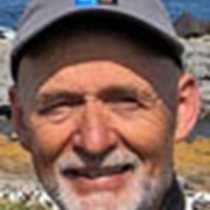Lofoten Islands, Norway
This first day of July the Arctic summer made its full entrance. In the early morning the National Geographic Endeavour came to Værøy at the western tip of Lofoten. In contrast to the low profile of the coastal landscape yesterday, the early risers this time were welcomed by mighty green-clad mountains. Værøy has for hundreds of years been home for many fishermen and remains important in the fisheries of Northern Norway.
We came ashore at the small, abandoned village of Måstad, once inhabited by fisherman farmers. The surviving houses are now used as summer homes by the grandchildren of the former islanders who left in the 1950s. Cod brought them income, but seabirds were a vital addition to their diet. It was here on Værøy that locals developed the “puffin dog” breed – the lundehund. These dogs were trained to search for puffins nesting under large rocks in the big cliff screes, at night in complete silence. To our amazement we met a summering couple who had a pair of lundehund descended from their own grandparents' dogs.
Another group went hiking along an old overgrown cart road leading to the only island church, on the other side of the mountain. In bad weather this handbuilt rock trackway was the only connection between Måstad and the main village on the opposite side of Værøy. On this summer day when all is heaven we can never imagine the winter hell in which men put to sea to earn a living out here. The photographers group went cruising on a flat, calm sea under cliffs echoing with the cries of breeding kittiwakes, as puffins paddled past.
After lunch our ship headed for Å, one of the best preserved fishing villages in Norway. Å is at the very end of the Lofoten road. Today there are 39 protected buildings in the village. A visit to the two local museums recreate life in a fishing village a hundred years ago. Helped by the favourable drying conditions in the village, 700,000 cod a year could be dried here on hillside fish racks. Our afternoon continued at another scenic fishing village – Reine – which we explored by Zodiac. The balmy Arctic evening inspired the galley to lay out our dinner on the pool deck. For a grand finale the National Geographic Endeavour nosed into the extremely narrow Trollfjorden, and our captain gently turned the vessel until we could pluck a single spray of rowan from the sheer cliff face.
This first day of July the Arctic summer made its full entrance. In the early morning the National Geographic Endeavour came to Værøy at the western tip of Lofoten. In contrast to the low profile of the coastal landscape yesterday, the early risers this time were welcomed by mighty green-clad mountains. Værøy has for hundreds of years been home for many fishermen and remains important in the fisheries of Northern Norway.
We came ashore at the small, abandoned village of Måstad, once inhabited by fisherman farmers. The surviving houses are now used as summer homes by the grandchildren of the former islanders who left in the 1950s. Cod brought them income, but seabirds were a vital addition to their diet. It was here on Værøy that locals developed the “puffin dog” breed – the lundehund. These dogs were trained to search for puffins nesting under large rocks in the big cliff screes, at night in complete silence. To our amazement we met a summering couple who had a pair of lundehund descended from their own grandparents' dogs.
Another group went hiking along an old overgrown cart road leading to the only island church, on the other side of the mountain. In bad weather this handbuilt rock trackway was the only connection between Måstad and the main village on the opposite side of Værøy. On this summer day when all is heaven we can never imagine the winter hell in which men put to sea to earn a living out here. The photographers group went cruising on a flat, calm sea under cliffs echoing with the cries of breeding kittiwakes, as puffins paddled past.
After lunch our ship headed for Å, one of the best preserved fishing villages in Norway. Å is at the very end of the Lofoten road. Today there are 39 protected buildings in the village. A visit to the two local museums recreate life in a fishing village a hundred years ago. Helped by the favourable drying conditions in the village, 700,000 cod a year could be dried here on hillside fish racks. Our afternoon continued at another scenic fishing village – Reine – which we explored by Zodiac. The balmy Arctic evening inspired the galley to lay out our dinner on the pool deck. For a grand finale the National Geographic Endeavour nosed into the extremely narrow Trollfjorden, and our captain gently turned the vessel until we could pluck a single spray of rowan from the sheer cliff face.




